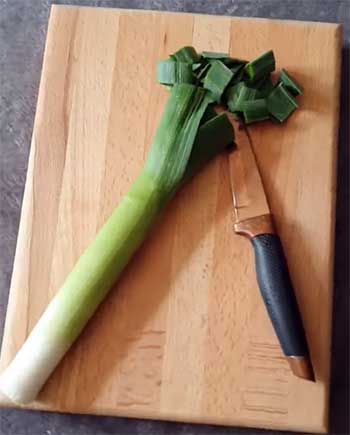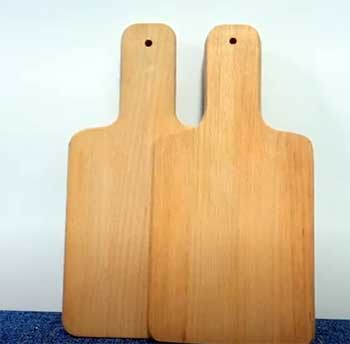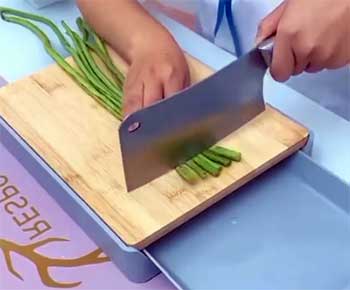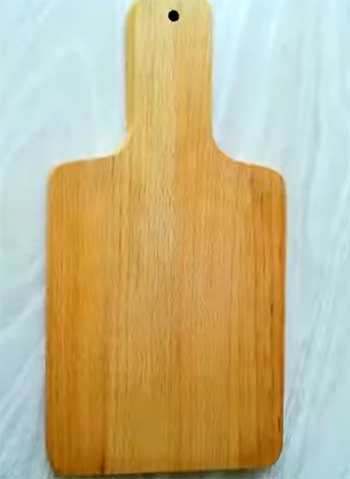I’ve spent countless hours in my kitchen, chopping, slicing, and dicing, and let me tell you, the right cutting board makes all the difference.
When it comes to choosing between beech and acacia cutting boards, I’ve learned it’s not just about picking a slab of wood—it’s about finding the perfect balance of durability, aesthetics, and knife-friendliness.
In this article, I’ll walk you through my experience with both, breaking down their pros and cons, comparing their key features, and helping you decide which one suits your cooking style best. Let’s get chopping!
A Brief Comparison Table
| Feature | Beech Cutting Board | Acacia Cutting Board |
| Hardness (Janka) | ~1300 | ~1750–2300 (varies by species) |
| Durability | Strong, resists wear | Very durable, resists scratches |
| Knife-Friendliness | Gentle on knives | Moderately gentle, may dull softer blades |
| Porosity | Fine pores, low bacteria absorption | Tight grain, natural oils reduce absorption |
| Maintenance | Regular oiling required | Moderate oiling, naturally water-resistant |
| Aesthetics | Light, uniform, less striking | Rich, varied grain, visually appealing |
| Price | Affordable (~$20–$50) | Slightly pricier (~$30–$80) |
| Weight | Moderate, easy to handle | Heavier, less portable |
| Sustainability | Widely available, moderately sustainable | Fast-growing, eco-friendly |
My Journey With Wooden Cutting Boards
As a home cook who’s passionate about everything from prepping vibrant salads to carving roasts, I’ve always valued a good cutting board. It’s the unsung hero of the kitchen, taking a beating so my countertops and knives don’t have to.
Over the years, I’ve tried various materials—plastic, bamboo, even glass (a mistake I won’t repeat)—but wooden boards have always felt like home. They’re warm, sturdy, and have a certain charm that elevates the cooking experience.
When I started comparing beech and acacia, I realized each brings something unique to the table, and I’m excited to share what I’ve discovered.
Understanding Beech Cutting Boards

Beech wood, sourced primarily from Europe and North America, is a hardwood known for its strength and fine grain.
With a Janka hardness rating of around 1300, it’s tough enough to handle daily chopping without being overly harsh on your knives.
I first encountered a beech cutting board at a friend’s house, and I was struck by its smooth, pale surface—almost like a blank canvas for my culinary creations.
Its tight, closed-grain structure makes it less porous, which means it doesn’t soak up juices or harbor bacteria as much as some other woods.
Pros of Beech Cutting Boards
- Durability That Holds Up
Beech is a workhorse. I’ve used my beech board for everything from slicing onions to breaking down a whole chicken, and it’s stood up to the challenge.
Its hardness ensures it resists deep cuts and scratches, maintaining a smooth surface over time. Unlike softer woods like pine, beech doesn’t develop unsightly gouges that can trap food particles.
- Knife-Friendly Surface
One of my biggest pet peeves is a cutting board that dulls my knives. Beech strikes a great balance—it’s hard enough to be durable but not so hard that it blunts your blades.
I’ve noticed my chef’s knife glides smoothly across the surface, making precise cuts without losing its edge. This is especially important if you’re using high-quality knives, like my prized Japanese santoku.
- Hygienic and Easy to Clean
The fine pores of beech wood make it naturally resistant to absorbing liquids and odors. When I spill tomato sauce or garlic paste on my beech board, a quick scrub with mild soap and water does the trick.
Studies, like one from UC Davis, have shown that hardwoods like beech have natural antibacterial properties, which gives me peace of mind when prepping raw meats.
- Affordable Price Point
Beech boards are wallet-friendly. I picked up a solid 18×12-inch beech board for around $25, which is a steal compared to pricier options like walnut or teak.
If you’re just starting to build your kitchen arsenal, beech is a practical choice that doesn’t skimp on quality.
- Subtle, Clean Aesthetic
Beech’s light cream or pale brown color gives it a minimalist, clean look that fits seamlessly into any kitchen.
It’s not as flashy as darker woods, but I find its understated elegance appealing, especially when I’m serving cheese or charcuterie directly on the board.
Cons of Beech Cutting Boards
- Maintenance Demands

Beech requires regular care to stay in top shape.
I learned this the hard way when my first beech board started to look dry and slightly warped after a few months of neglect.
You’ll need to oil it monthly with food-grade mineral oil to prevent drying out or cracking.
If you’re not into routine maintenance, this could be a hassle.
- Susceptibility to Stains
The light color of beech, while attractive, is a magnet for stains. I once left some beet juice on my board for too long, and it took some serious scrubbing to get it out.
Darker woods like acacia hide stains better, so if you cook with vibrant ingredients, beech might require extra cleaning effort.
- Prone to Shrinking and Swelling
Beech can be sensitive to moisture. If you leave it soaking in water or expose it to high humidity, it may swell or even split along the grain.
I make it a point to dry my board thoroughly after washing to avoid these issues, but it’s something to keep in mind.
- Less Visually Striking
While I appreciate beech’s simplicity, it lacks the wow factor of woods with bold grain patterns.
If you’re looking for a cutting board that doubles as a statement piece for your kitchen, beech might feel a bit plain compared to acacia’s vibrant hues.
Exploring Acacia Cutting Boards
Acacia wood, often sourced from Asia, Africa, or Australia, is a hardwood that’s gained popularity for its durability and stunning aesthetics. With a Janka hardness rating ranging from 1750 to 2300 (depending on the species), it’s denser than beech, making it a robust choice for heavy-duty kitchen tasks.
My first acacia board caught my eye with its rich, reddish-brown tones and swirling grain patterns—it’s like a piece of art you can chop carrots on.
Pros of Acacia Cutting Boards

- Exceptional Durability: Acacia is a beast when it comes to durability. I’ve used my acacia board for years, and it still looks nearly new despite daily use. Its dense structure resists scratches and knife marks, which is great for someone like me who tends to get a bit aggressive with a cleaver when prepping meats.
- Natural Water Resistance: Thanks to its natural oils, acacia is inherently water-resistant. I’ve accidentally left my board wet after washing, and it didn’t warp or crack—a testament to its resilience. This makes it a solid choice for kitchens where moisture is a constant, like when you’re prepping juicy fruits or marinated proteins.
- Antibacterial Properties: Like beech, acacia has natural antibacterial qualities. I feel confident using it for raw meats, knowing that the wood’s tight grain and oils help inhibit bacterial growth. This is a big plus for anyone prioritizing food safety.
- Eye-Catching Aesthetics: Acacia’s grain patterns are a showstopper. The mix of light sapwood and darker heartwood creates a dynamic, almost painterly effect. I’ve received compliments from guests when I use my acacia board as a serving platter for appetizers—it’s both functional and gorgeous.
- Eco-Friendly and Sustainable: Acacia trees grow quickly, making them a sustainable choice. I love knowing that my acacia board comes from a renewable resource, especially since I try to make eco-conscious choices in my kitchen. Countries like Vietnam and Thailand have leaned into acacia’s abundance, making it widely available and affordable.
Cons of Acacia Cutting Boards
- Potential to Dull Knives: Acacia’s higher hardness can be a double-edged sword. While it’s great for durability, it can be tougher on knives, especially softer steel blades. I’ve noticed my older knives need sharpening a bit more often when I use my acacia board compared to my beech one.
- Heavier Weight: Acacia boards tend to be heavier than beech. My 20×15-inch acacia board feels like a workout to lift, which can be a drawback if you’re moving it around frequently or have a small kitchen with limited storage.
- Maintenance Needs: While acacia is lower-maintenance than beech due to its natural oils, it still requires periodic oiling to prevent drying out. I oil mine every couple of months, which is less frequent than beech but still a commitment. Neglecting this can lead to cracks or a dull appearance.
- Inconsistent Grain Patterns: Acacia’s grain can be unpredictable, with knots or irregularities that some might find charming and others might see as flaws. My board has a few knots, which add character but can make the surface slightly uneven in spots.
- Slightly Higher Cost: Acacia boards are often pricier than beech, with good-quality ones ranging from $30 to $80. While still affordable compared to premium woods like walnut, the cost can add up if you’re buying a larger or end-grain board.
Beech Vs. Acacia: A Side-by-Side Analysis
- Hardness and Durability
Beech, with its Janka rating of 1300, is durable enough for everyday use but slightly less robust than acacia, which can hit up to 2300 Janka. In my experience, acacia holds up better to heavy chopping, like when I’m breaking down tough root vegetables or bones.
However, beech’s moderate hardness makes it a bit more forgiving on knives, which is a win if you’re protective of your blades.
- Knife-Friendliness
Both woods are generally knife-friendly, but beech has a slight edge here. Its softer surface means less wear on your blades over time. Acacia, while still gentle compared to materials like bamboo or glass, can dull softer knives faster due to its density.
If you own high-end Japanese knives with brittle edges, beech might be the safer bet.
- Porosity and Hygiene
Both beech and acacia have tight, closed-grain structures, making them resistant to bacteria and moisture. Acacia’s natural oils give it a slight advantage in water resistance, but beech’s fine pores are excellent at preventing liquid absorption.
I’ve found both to be hygienic with proper cleaning, though acacia’s oils make it a bit more forgiving if you’re occasionally lax with maintenance.
- Maintenance Requirements
Beech demands more attention, needing monthly oiling to prevent drying or warping. Acacia, with its natural oils, can go longer between oiling sessions—every two to three months in my case.
If you’re like me and sometimes forget to oil your board, acacia might be the more practical choice.
- Aesthetics and Kitchen Appeal
This one’s subjective, but acacia steals the show for me. Its vibrant, varied grain patterns make it a focal point in my kitchen, while beech’s uniform, pale look feels more utilitarian.
If you want a board that doubles as a serving piece, acacia’s beauty is hard to beat. Beech, however, blends effortlessly into minimalist or modern kitchens.
- Price and Value
Beech is the budget-friendly option, often costing $20–$50 for a decent board. Acacia is slightly pricier, ranging from $30–$80, but its durability and aesthetics justify the cost for many.
I’ve found that both offer great value, but beech is ideal if you’re watching your wallet.
- Sustainability
Acacia’s fast-growing nature makes it a more sustainable choice, especially since it’s often sourced from responsibly managed plantations.
Beech is widely available, particularly in Europe, but its slower growth rate makes it slightly less eco-friendly. If sustainability is a priority for you, acacia might align better with your values.
- Weight and Portability
Beech boards are generally lighter, making them easier to move and store. My acacia board, while sturdy, can feel cumbersome when I’m cleaning it or tucking it away.
If you have limited counter space or prefer a board you can easily maneuver, beech has the upper hand.
My Experience With Beech And Acacia Cutting Board

To give you a sense of how these boards perform in real life, let me share a few scenarios.
Last Thanksgiving, I used my beech board to prep a massive spread—chopping herbs, dicing vegetables, and carving a turkey.
It handled everything beautifully, with minimal knife marks and easy cleanup.
The light color made it easy to spot any stray bits of food, ensuring a clean surface for each task.
On the other hand, my acacia board has been my go-to for entertaining.
I recently hosted a wine-and-cheese night, and the board’s rich grain patterns made it a stunning centerpiece for my charcuterie spread.
Guests couldn’t stop commenting on its beauty, and it held up perfectly under heavy use, even when I was slicing crusty baguettes with a serrated knife. However, I did notice my older paring knife needed a quick hone afterward, likely due to acacia’s harder surface.
Choosing The Right Board For You
Your choice between beech and acacia depends on your cooking habits, aesthetic preferences, and maintenance commitment. If you’re a busy cook who values affordability and low-maintenance hygiene, beech is a solid pick.
Its light color and knife-friendly surface make it ideal for everyday tasks, though you’ll need to stay on top of oiling. If you want a board that’s both a kitchen workhorse and a showpiece, acacia’s durability, water resistance, and striking looks are hard to beat, especially if you don’t mind its weight or slightly higher cost.
For me, it’s not about one being better than the other—it’s about what fits your lifestyle. I keep both in my kitchen: beech for quick, daily prep and acacia for special occasions or heavy-duty tasks.
Consider how often you cook, the types of knives you use, and whether you want a board that’s more functional or visually impressive.
Frequently Asked Questions (FAQ)
It depends on your needs. Beech is more affordable and gentler on knives, ideal for daily use and budget-conscious cooks. Acacia is more durable, water-resistant, and visually striking, perfect for those who want a premium, low-maintenance board.
Yes, beech is excellent for cutting boards. Its hardness, fine pores, and natural antibacterial properties make it durable and hygienic, though it requires regular oiling to prevent drying or warping.
Acacia can dull knives faster due to its hardness, is heavier, requires periodic oiling, and has unpredictable grain patterns that may include knots. It’s also slightly more expensive than beech.
Maple is the industry standard for its durability and knife-friendliness, but beech, acacia, walnut, and cherry are also excellent. Choose based on hardness, porosity, and maintenance needs—closed-grain hardwoods are ideal.
Conclusion: Your Perfect Cutting Board Awaits
You’re now armed with everything you need to choose between a beech and acacia cutting board. I’ve shared my experiences, from the practical reliability of beech to the stunning durability of acacia, to help you find the board that fits your kitchen and cooking style.
Whether you prioritize affordability, knife care, or aesthetics, both woods offer unique strengths. Take a moment to think about what matters most to you—durability, ease of maintenance, or that wow factor—and pick the board that’ll make your time in the kitchen even more enjoyable.
Happy chopping!
